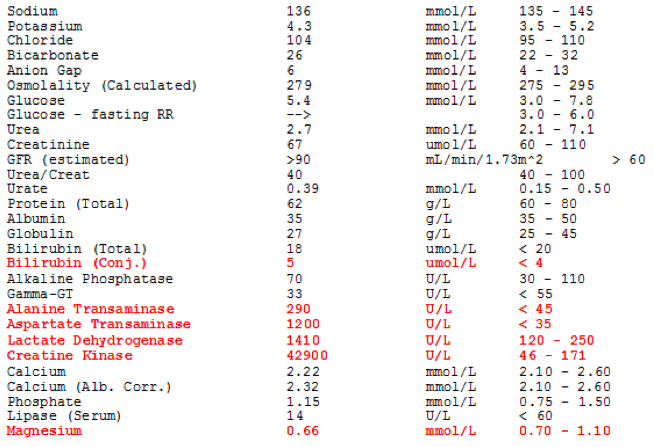A 25-year-old Female with a Mysterious Myalgia
This case has been inspired by events in the Torres Straits and details have been changed to ensure patient anonymity.
History
A 25-year old previously well female presented to the remote area nurse on an outer island somewhere in the Torres after being carried into the clinic by her family. She had woken that morning with severe muscle pains in her neck, back, abdomen and hips. She described the pain as ‘just like a cramp’ and denied joint pains, nausea, vomiting, fevers and bowel or bladder symptoms.
The patient had been Crayfish diving the day prior but can’t remember being stung by anything in the water. She ate cooked boxfish the night before – a regular meal in her family. She didn’t drink alcohol and denied drug use.
Clinical Findings
Looks uncomfortable. Observations within normal limits, afebrile. Cardiovascular, respiratory and neurological examinations unremarkable. She would become distressed with minor body movements.
Blood sugar 5.7mmol/L
ECG Normal Sinus Rhythm
Urine looked like coca-cola
What are your differential diagnoses?
How would you approach this patient?
The Case Continued…
She was initially given IV morphine, normal saline and magnesium before being transferred into Thursday Island Hospital for further management. Her initial creatinine kinase was 1700 which climbed to 42900 the following day. She was treated for rhabdomyolysis secondary to presumed boxfish envenomation. The patient made a full recovery with supportive care (IV fluids and analgesia) on the ward and was discharged home two days later with normalised creatinine kinase levels and renal function.
Initial creatinine kinase:

Maximal creatinine kinase during admission (surprisingly her electrolytes were preserved):

Urine contents during admission:
Pearls from the Torres
Rhabdomyolysis is the destruction of skeletal muscle tissue of which the byproducts can be systemically toxic. It can be precipitated by by a myriad of things including excessive exercise, prolonged immobilization, drugs and toxins. Whilst many patients may be asymptomatic, some will present with discolored urine (secondary to myoglobinurea), myalgia, weakness, renal impairment and in severe cases shock.
In this case it was suspected that the rhabdomyolysis was caused by consumption of boxfish. Boxfish are closely related to pufferfish and excrete a toxin called pahutoxin when they are under stress. The phenomenon of developing unexplained rhabdomyolysis within 24hours of ingesting fish is known as Haff disease. It was first described around Germany in the early twentieth century and has been linked with the consumption of buffalo fish, however the literature associated with boxfish is scant. Thus this case of myalgias will remain a mystery.

Further Reading
Rhabdomyolysis:
https://lifeinthefastlane.com/ccc/rhabdomyolysis/
Haff Disease:
https://www.ncbi.nlm.nih.gov/pmc/articles/PMC4162725/
https://www.ncbi.nlm.nih.gov/pubmed/25789572